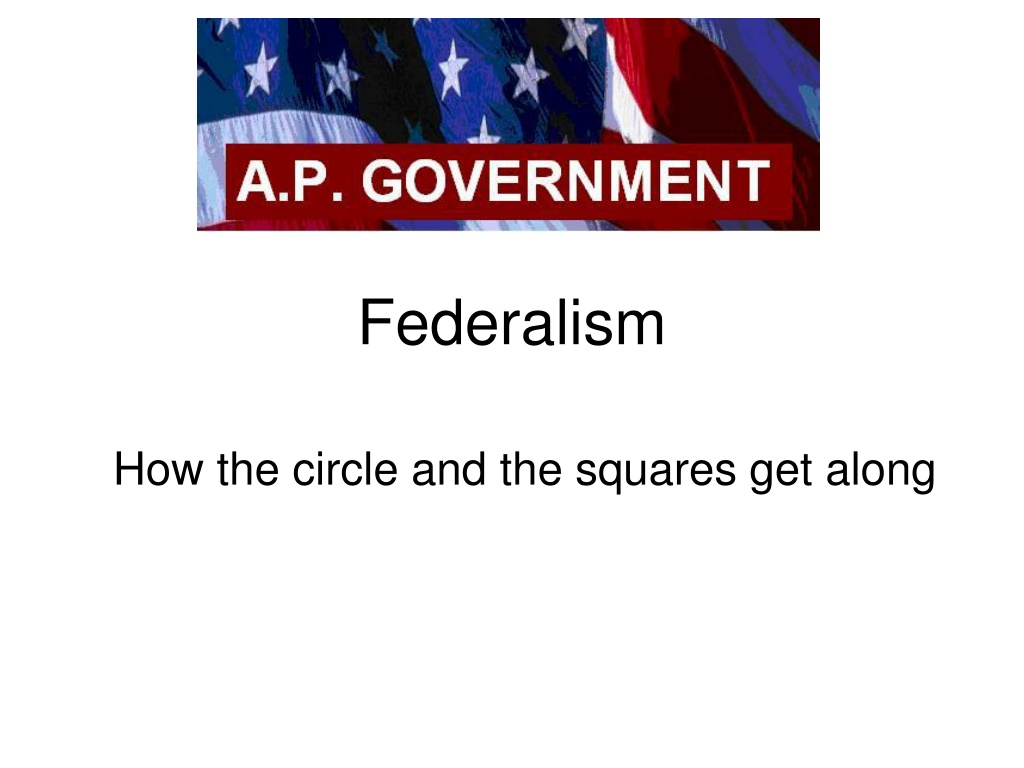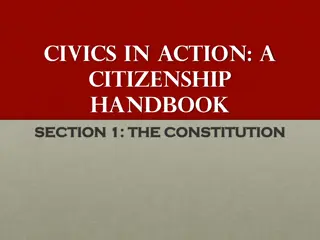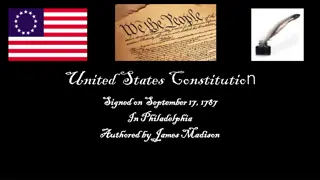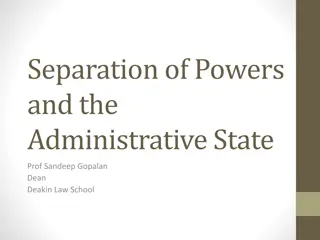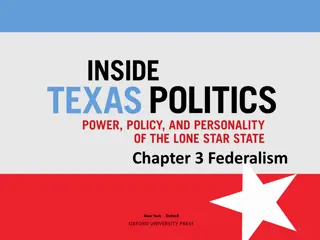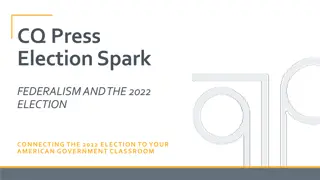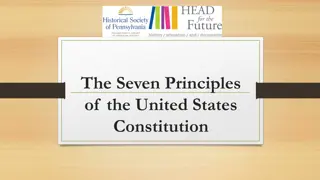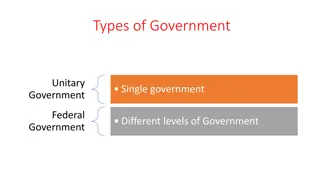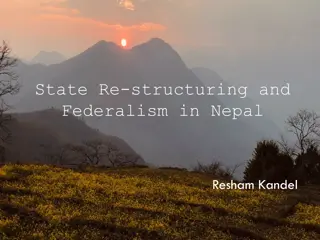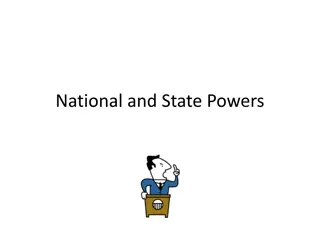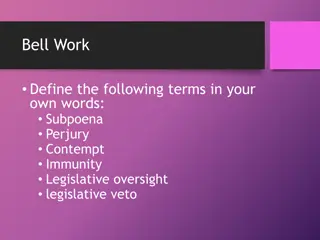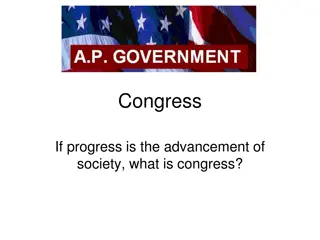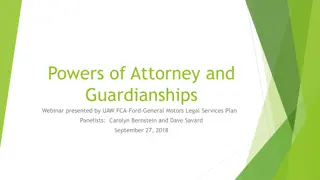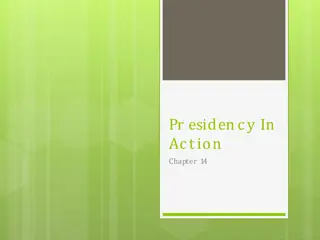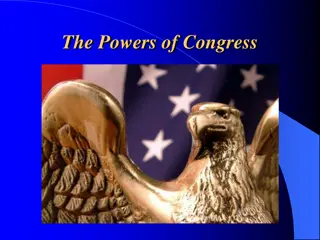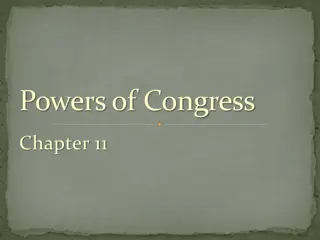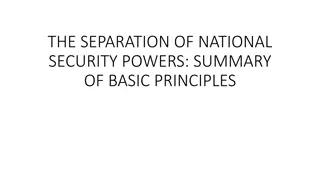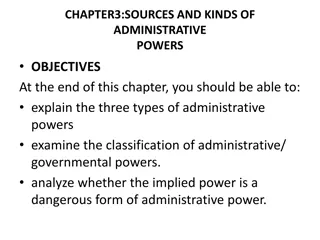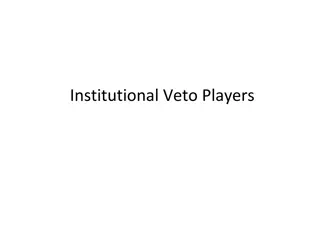Understanding Federalism: Powers, Relationships, and Key Terms
Explore the concept of Federalism through the relationship between the federal government (circle) and state governments (squares). Discover the powers involved such as Delegated, Reserved, Concurrent, and Prohibited powers. Delve into significant cases like McCulloch v. Maryland, terms like the Elastic Clause, and the principles of Dual and Cooperative Federalism. Consider the impact of grants-in-aid, block grants, and mandates along with the pros and cons of Federalism.
Download Presentation

Please find below an Image/Link to download the presentation.
The content on the website is provided AS IS for your information and personal use only. It may not be sold, licensed, or shared on other websites without obtaining consent from the author. Download presentation by click this link. If you encounter any issues during the download, it is possible that the publisher has removed the file from their server.
E N D
Presentation Transcript
Federalism How the circle and the squares get along
Terms you need to know after this presentation Federalism Federalist #51 Delegated powers Reserved powers Concurrent powers Prohibited powers Elastic clause McCulloch v. Maryland (1819) Commerce clause Gibbons v. Ogden (1824) Dual Federalism Cooperative Federalism Grants-in-aid Categorical grant Block grant Mandate Devolution Pros and cons of federalism
Disaster Relief Who s job was it to clean up New Orleans and the rest of the coast after Katrina?
No Child Left Behind Should the national gov t step in to regulate school performance?
What is Federalism? Federalism Two or more governments exercise power and authority over the same people in the same territory OR the relationship between the federal government (circle) and the state governments (squares)
Federalist #51 Defends the Constitution Explains why a strong gov t is necessary If men were angels, no government would be necessary. If angels were to govern men, neither external nor internal controls on government would be necessary. Defends separation of powers between state and national gov t
Powers - Delegated Powers (enumerated powers) powers given to Fed gov t by Constitution - Reserved Powers state power alone - Concurrent Powers shared - Prohibited Powers denied from both - Ex. Neither gov t can tax exports
Elastic Clause Aka Necessary and Proper Clause Art. I, Sec. 8, Cl. 18 - "The Congress shall have Power - To make all Laws which shall be necessary and proper for carrying into Execution the foregoing Powers, and all other Powers vested by this Constitution in the Government of the United States, or in any Department or Officer thereof." Impossible to predict all powers Congress will need to function, sometimes we might have to allow Congress extra powers to fulfill their delegated powers
McCulloch v. Maryland (1819) Background Bank of the US operated in Maryland Maryland did not want BoUS to operate in state, competition unwanted, unfair Maryland taxed the bank to put it out of business McCulloch, BoUS employee, refused to pay the state tax
McCulloch v. Maryland (1819) Is a Bank of the US Constitutional? YES. The national gov t has certain implied powers that go beyond delegated powers. US needs a national bank for borrowing, lending, holding minted money, etc. All of which are delegated powers.
McCulloch v. Maryland (1819) Can a state tax the federal gov t? -NO. The federal gov t is supreme. Since the BoUS is constitutional, only the feds may tax it. -John Marshall reaffirmed Supremacy Clause and Elastic Clause -National (Federal) Gov gets STRONGER
Commerce clause Art. I, Sec. 8, Cl. 3 The Congress shall have power - To regulate commerce with foreign nations, and among the several states, and with the Indian tribes. Congress has used the elastic clause to stretch this power What is commerce? Buying and selling of goods and services. Congress given the power to regulate commerce between foreign countries and US as well as state to state they control business law.
Gibbons v. Ogden (1824) 1824 aka The Steamboat Case Ogden received a state licensed monopoly to run a ferry across the Hudson River Gibbons also saw the potential of the traffic between NJ and NY and obtained a federal license. Ogden sued saying he had the valid state license, even though Gibbons had US license
Gibbons v. Ogden (1824) Result Gibbons wins Expanded national power in all areas of commerce law because nation overruled state in interstate trade issues Fed Gov t gets STRONGER All trade today is primarily controlled by national law
Commerce Clause Who cares? Why is it important? Gibbons v. Ogden ruling makes a loop hole giving Congress power to take control over any issue involving the movement of people, or things Fed gov t power increased
United States v. Lopez (1995) Commerce clause quiz!!! 1995 Gun Free School Zone law banned possession of a firearm within 1000 feet of a school, 12 year old Lopez carried a gun on to the property Declared law unconstitutional nothing to do with commerce carrying a weapon through a school zone is too much of a stretch for commerce LIMITED National government power
Gonzalez v. Raich (2005) Commerce clause quiz!!! Medicinal Marijuana Controlled Substance Act (1970) US gov regulates the manufacture, importation, possession, and distribution of certain drugs Medicinal marijuana was legalized in California, but illegal to US government. Raich argued commerce clause should not take effect because 1) there was no business transactions and 2) there were no state border issues. Supreme Court ruled 6-3 against Raich saying that the federal government could trump state laws that permitted medicinal marijuana
2 Federalisms? OLD SCHOOL Dual Federalism Federal and state governments remain dominant in their separate spheres of influence Gibbons v. Ogden proved life is not that simple NEW SCHOOL Cooperative Federalism State and Federal governments work together to solve complex problems
2 Federalisms TWO METAPHORS Dual Federalism Layer Cake Federal State Cooperative Federalism Marble Cake
Fiscal Federalism Fiscal means $ Q How do you get the states to do things they normally wouldn t do? A Money Q What is the answer to any question ever asked? A Money
Grants-in-Aid Money paid from one level of government to another to be spent for a specific purpose Categorical Grants - target specific purposes and strings attached. (States receive funds if state raised age to 21 and lowered BAC to .08) Block Grants given for broad, general purposes and allow more discretion on how the money is spent (ex. Welfare reform)
Mandates A requirement that a state undertake an activity or provide a service Most apply to Civil Rights and the Environment Often times the states or local gov ts have to pay the bill of the mandate set by Congress
Mandates 1986 Asbestos Emergency Response Act, Handicapped Children s Protection Act 1988 Drug-free Workplace Acts, Ocean Dumping Ban Act 1990 Clean Air Act EX Columbus, OH spends 23% of the city budget trying to meet environmental mandates (including testing for pesticides used on rice and pineapple) EX Public schools have to use Internet filtering or schools lose e-rate subsidies
Change in Spending Shift towards Federal Gov t Spending Federal State Local (City) 1929 17% 23% 60% 1939 47% 23% 30% 1960 64% 17% 19% 1997 66% 19% 15%
Devolution Devolution is the return of power to the state gov Idea is fueled by distrust of the federal gov and the desire to save money by reducing the size of the bloated federal government
Devolution Example Personal Responsibility and Work Opportunity Reconciliation Act of 1996 Eliminated welfare and transferred the money to states as block grants States received wide latitude on how to administer workfare but with the knowledge that Congress was counting on anti- poverty spending Strings attached: head of family must work or lose benefit; lifetime benefits limited to 5 years; unmarried mother < 18 only receive $ if stay in school and live with adult; immigrants ineligible for 5 years
Federalism is good Living under 2 governments is great Built on compromise, promotes unity Gov t duties can be split up Brings gov t closer to people Allows for state gov t to address issues in unique regions of the country Allows states to experiment with policy before enacting it at the federal level Ex. Vermont s free health care for children
Federalism is bad Living under 2 governments is bad States can impede progress of Nation States are unequal States have different policy Easier for states to be dominated by interest groups
